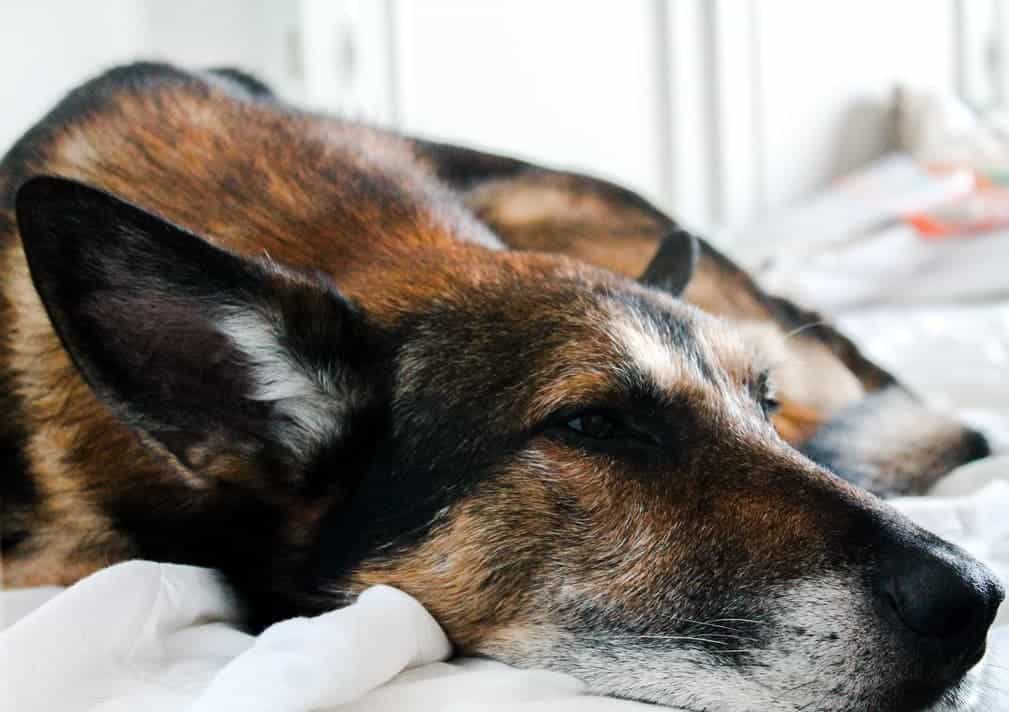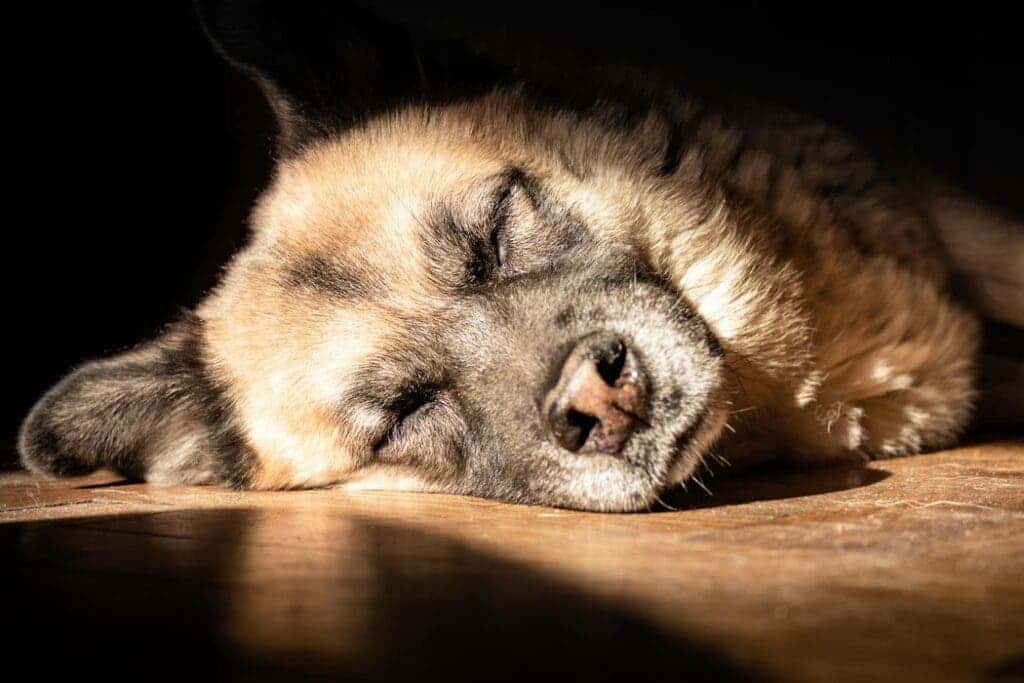You’ve probably seen it happen: your sleeping dog suddenly lets out a woof or a sigh as his legs begin to twitch or move as if he’s running. Is he… dreaming? Many scientists say that dogs, in fact, experience dreams and that the type of dream can vary depending on the size, breed, or other features of the dog.
Here’s what the science on dog dreaming says.

Most dog owners have, at some point, observed their dogs doing a peculiar thing: at various times during their sleep, the dogs would quiver, make leg twitches, or may even growl or snap at some sleep-created phantom. It almost seems like the dogs are having intense dreams, or at least that’s what many owners think. And the owners are actually right.
At the structural level, the brains of dogs are fairly similar to those of humans. Also, during sleep, the brain wave patterns of dogs are similar to that of humans and go through the same stages of electrical activity observed in humans, all of which are consistent with the idea that dogs are dreaming.
While science on dreaming is always bound to be scarce, there’s actually some fairly convincing evidence behind the fact that dogs dream.
Doggy dreams
Just like you and I, dogs enjoy a good nap. In fact, it’s not uncommon for dogs to sleep for 12-14 hours a day. Like humans, a dog’s sleep cycles through stages of wakefulness, rapid-eye-movement (REM) sleep, and non-rapid-eye-movement sleep. Scientists recorded the electrical activity of the brains of six pointer dogs for 24 hours and found that the dogs spent 44 percent of their time alert, 21 percent drowsy, and 12 percent in REM sleep. They also spent 23 percent of their time in the deepest stage of non-REM sleep.
One of the most famous of these dream experiments involved lab rats and was carried out in 2001. These rats spent all day running in a maze, after which scientists monitored the brain activity of the rats in the maze and compared it to the brain activity of the rats during REM sleep. What they found was that the same areas lit up in the rats’ brains, suggesting that the rats were likely to be dreaming of the maze. By comparing the data, the researchers could guess where exactly in the maze the rats had dreamed themselves. The rats were “seeing” what they were dreaming about, the researchers said at the time.
“During dreams, at least, it is likely that animals form mental representations and have conscious experiences very similar to those of humans,” writes psychologist Christopher D. Frith.
This suggested to the researchers that animals tend to dream as we do, which makes a lot of sense. Sleep is a way through which we rest, but also build memories and mental shortcuts, cementing and structuring the information we’ve gathered through the day.
Dreams are also suspected to play a role in this, so it’s not surprising that other animals would also dream (although it’s relatively recent that science was actually able to prove this). The rats dreamed about their day, just like you might find yourself back in the office in your dreams, even if you would rather have dreamed yourself someplace more exciting.

Researchers at MIT who carried out the 2001 study concluded that many animals probably have complex dreams, and they can remember and replay long sequences of events when they are asleep. Another 2016 study found that dogs who sleep more are happier, so if you see your furry friend taking a nap, don’t disturb them.
Another recent, 2020 study found that sleep “sleep may contribute to dogs’ memory consolidation”.
What dogs dream about
Much of the dreaming that all of us do at night is associated with the activities that you engaged in that day. Studies showed that this seems to be the case in rats and probably other mammals like dogs and cats too.
The full range of dog dreams is currently impossible to assess. But here’s what we do know.
If rats dream of things they’ve done during the day and humans do too, it’s likely that dogs also do it. There’s even a study suggesting this — so although the evidence is not entirely conclusive, it’s very likely that this type of dream is fairly common among dogs.
There is also evidence that they dream about common dog activities. This kind of research takes advantage of the fact that there is a special structure in the brainstem (the pons) that keeps all of us from acting out our dreams.
When scientists removed or inactivated the part of the brain that suppresses acting out of dreams in dogs, they observed that they began to move around, despite the fact that electrical recordings of their brains indicated that the dogs were still fast asleep. The dogs only started to move when the brain entered that stage of sleep associated with dreaming. During the course of a dream episode, these dogs actually began to execute the actions that they were performing in their dreams.
Does the breed affect a dog’s dreams?

People vary as to how often they dream and what they dream about, and researchers believe that the same is true of dogs. Researchers reported that small dogs seem to have more frequent dreams than large dogs, but those small dog dreams are shorter in duration. Large dogs, on the other hand, have fewer, but longer dreams.
Research by psychologist Stanley Coren suggests that the length and frequency of dreams may be related to the animals’ size entirely. For example, a poodle may dream every 10 minutes, while a big labrador retriever may only dream once every 60 minutes. However, the length of the poodle’s dreams may only last a minute, while the labradors’ dreams may last 10 minutes long.
We can also chance a guess that what your dog does all day determines his dreams. While we can’t yet be sure, the fact that Pointers point and Dobermans display guard behavior implies that breed-specific activities may take place during dreams, too. Your labrador retriever, for instance, is more likely to dream about chasing tennis balls than a pug is.
Do dogs have nightmares?
Not all human dreams are good. We can infer that dogs can have nightmares, too. These nightmares are hard to watch as we all want the best for our doggie friends. But while it can be tempting to wake your dog to comfort her, as you would a child, there are some risks associated with doggy nightmares that you should know (and share with your family).
If you’ve ever been woken from a scary dream, you know that it can take a minute to remember where you are and who you are with. Like some people, dogs can react aggressively toward the person waking them. This can be dangerous, especially for children. The best thing that you can do for a dog you think is having a bad dream is to wait for your dog to wake up and be there to comfort him, following the old saying “let sleeping dogs lie.”
Dogs can also get narcolepsy, a disorder that causes the brain to fall into sudden sleep. In fact, research into a line of narcoleptic dogs at Stanford University helped unravel the biochemistry behind the human form of the condition.
The best way to give your dog pleasant dreams? Keep them happy
The best way to give ourselves or our children better dreams is to have happy daytime experiences and to get plenty of sleep in a safe and comfortable environment. This is also the best thing you can do. Nightmares may creep in from time to time, but a healthy, happy dog will have nice dreams.
The more your pup’s day is filled with fun and excitement, the more likely their dreams will be too. This can also include treat training that will stimulate your dog’s brain and provide them with plenty of fun mental challenges. Ensuring they enjoy their daily dog walk will also make a big difference.



